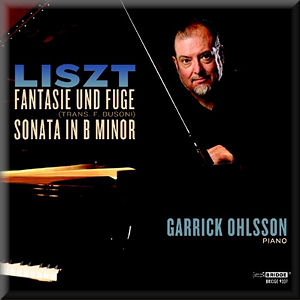 |
 |
|


alternatively
CD: MDT
AmazonUK
AmazonUS
|
Franz LISZT (1811-1886)
Fantasie and Fugue on “Ad nos, ad salutarem undam” S259 (transc.
Ferruccio Busoni, BV B 59) (1850) [28:45]
Sonata in B minor S178 (1852/53) [32:28]
 Garrick Ohlsson (piano)
Garrick Ohlsson (piano)
rcc. April 2009, Recital Hall of the Performing Arts Center, State
University of New York, Purchase, NY
 BRIDGE RECORDS 9337 [61:20]
BRIDGE RECORDS 9337 [61:20] 
|
|
|
Having greatly enjoyed Garrick Ohlsson’s Chopin via the Hyperion
label I was intrigued to hear what he would do with one of the
cornerstone solo works of the 19th century. Liszt’s
Sonata in B minor is not quite the tough nut one might
imagine, and despite a lack of any big tunes and a certain aura
of enigmatic impenetrability its deserved popularity does derive
from a clarity of memorable thematic content, high drama, and
quite a significant amount of lyrical tenderness.
This is a fine recording from the Bridge label, and I like Garrick
Ohlsson’s performance. He creates a nice sense of anticipation
in the enigmatic opening, is dramatic and dark with Liszt’s
turbulent theme and its development, opening out with fine grandeur
in the transition to a very nice poetic feel in the slower section
from about 5 minutes in. Not all recordings divide this piece
into different tracks, but here we are given four main sections
with access points which can be very handy for study purposes.
The spectacular passages are given a sense of full abandon,
and while the inner voices could sometimes be clearer there
can be no denying Ohlsson’s technical chops in dealing with
Liszt’s demands. He doesn’t make it sound effortless, but nor
is there ever a feel of going beyond the edge of control. The
prayer-like Andante sostenuto is very fine, taking us
to an entirely different and entirely tranquil world, and the
final Allegro energico with its fugal counterpoint is
uncompromisingly hard-driven but not lacking in touches of eccentric
wit. Despite this work’s fearsome reputation, Ohlsson actually
makes the Sonata in B minor a good deal more approachable
than some other players, and I’ve learned a good deal through
his healthily sanguine approach to the piece.
There are numerous good recordings of the Sonata in B minor
around. Arnaldo Cohen on the BIS label (see review)
is more gruffly dramatic and extreme than Ohlsson, creating
a wider range of contrast which brings out the sostenuto
centre of the piece very effectively. Louis Lortie is more accurate
than Cohen in the wilder passages on his Chandos recording,
but more overtly expressive – in the middle of the first movement
for instance – obtaining more of a songlike melodic line but
shaping these with rubati which may not always appeal on repeated
listening. Mykola Suk on the Music and Arts label is also acclaimed,
as is Marc-André Hamelin on Hyperion. I don’t have a particular
favourite amongst this rather cursory handful of comparisons,
but would point out that Garrick Ohlsson’s recording is rather
up against it in actually beating the best of the competition.
It’s very good indeed, but if you want to be gasping in amazement
and rooted to your chair with angst and ecstasy then the likes
of Lortie and Cohen will go further. If however you’ve been
put off this piece in the past and are seeking a new ‘way in’
then Ohlsson may well be your man. I like his clarity and sense
of human scale in the work, and came away feeling more inspired
than cudgelled.
The coupling here, the Fantasie and Fugue on “Ad nos, ad
salutarem undam” started out as a work for organ, and as
the opening promises it gives us even tougher piano noises than
those of the Sonata, Ohlsson’s massive power even sending
the recorded level into mild distortion at peaks on my system.
Busoni is responsible for a good deal of the extra oomph in
the piano writing for this version of the piece, adding “arpeggiated
figuration and chordal repetitions that give the solo piano
version a thrilling hyper-virtuosic character” as described
by Robert Arctor in the booklet notes. This is indeed a pianistic
tour de force to which Garrick Ohlsson is more than equal,
though there are moments of sometimes quite magical repose which
help us survive the onslaught. I have to say I prefer the organ
original with its multitudinous kaleidoscope of colours, but
this is certainly a potent and impressive performance and Ohlsson
makes as convincing an argument as I can imagine for this version,
though I doubt it’s going to become an easy-listening favourite.
This is a release which will have its appeal for piano fans
and fanatics. I don’t feel it pushes aside the great recordings
of the Sonata in B minor, but do feel it earns a place
amongst numerous respected alternatives. You won’t find the
Fantasie und Fuge much elsewhere in the form in which
it appears here, so there’s at least one big excuse for acquiring
this CD, and I very much doubt you’ll be disappointed with either
of these great works or their skilful guide.
Dominy Clements
|
|

